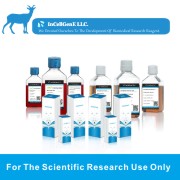

Overview
| Organism | Homo sapiens, human |
|---|---|
| Tissue | stomach; derived from metastatic site: liver |
| Product Format | frozen |
| Morphology | epithelial |
| Culture Properties | adherent |
| Biosafety Level |
1
Biosafety classification is based on U.S. Public Health Service Guidelines, it is the responsibility of the customer to ensure that their facilities comply with biosafety regulations for their own country. |
| Disease | gastric carcinoma |
| Gender | male |
| Storage Conditions | liquid nitrogen vapor phase |
Properties
| Karyotype | near diploid; DM were present in 64% of cells examined |
|---|---|
| Clinical Data |
male
|
| Receptor Expression |
acetylcholine, muscarinic, expressed
|
| Oncogene | myc +; erb B2 + |
| Tumorigenic | Yes |
| Effects |
Yes, the cells form tumors in athymic nude mice
|
| Comments |
NCI-N87 cells express the surface glycoproteins carcinoembryonic antigen (CEA) and TAG 72, and are L-dopa decarboxylase (DDC) negative. They were minimally positive for vasoactive intestinal peptide (VIP) receptors and lacked gastrin receptors. They were found to express receptors for muscarinic cholinergic agents. No evidence of amplification or rearrangements was noted with the N-myc, L-myc, myb and EGF receptor genes. The cell line expressed levels of c-myc and c-erb-B 2 RNA that were comparable to other cell lines.There was no expression of the following genes: N-myc, L-myc, c-cis, IGF-2, or gastrin releasing peptide. NCI-N87 cells have a reported plating efficiency of 4.3%.
|
Background
| Complete Growth Medium |
The base medium for this cell line is ATCC-formulated RPMI-1640 Medium, ATCC 30-2001. To make the complete growth medium, add the following components to the base medium: fetal bovine serum (ATCC 30-2020) to a final concentration of 10%. |
|---|---|
| Subculturing |
Volumes are given for a 75 cm2 flask. Increase or decrease the amount of dissociation medium needed proportionally for culture vessels of other sizes.
Subcultivation Ratio: A subcultivation ratio of 1:3 to 1:4 is recommended
Medium Renewal: Two to three times weekly
|
| Cryopreservation |
Freeze medium: Complete growth medium supplemented with 5% (v/v) DMSO
Storage temperature: liquid nitrogen vapor phase
|
| Culture Conditions |
Atmosphere: air, 95%; carbon dioxide (CO2), 5%
Temperature: 37��C
Growth Conditions: They grow as an adherent monolayer of tightly knit epithelial cells.
|


